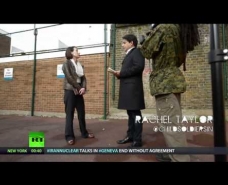U.N. calls on U.S. to ensure voluntary nature of ASVAB testing; U.S. denies ASVAB is required

The National Coalition to Protect Student Privacy -
In early 2013 The UN's Committee on the Rights of the Child called on the Obama Administration to "Ensure that schools, parents and pupils are made aware of the voluntary nature of the ASVAB before consenting to the participation into it." See the Concluding observations on the Second Report of the United States of America, Adopted by the Committee on the Rights of the Child at its sixty-second session (14 January–5 2013) regarding the Optional Protocol on the Involvement of Children in Armed Conflict See Concluding Observations
The Committee had previously found that "Parents and children are often unaware of the voluntary nature of the Armed Services Vocational Aptitude Battery (ASVAB) test organized in schools or its links to the military and that in some instances students were reportedly informed that the test was mandatory." Members of the Committee in Geneva found it incredulous that a thousand American schools force underage children to take this military test without parental consent.
The United States ratified the Optional Protocol to the Convention on the Rights of the Child on the Involvement of Children in Armed Conflict (OPAC) in 2002. Article 3.3 of OPAC states recruitment practices involving minors should be voluntary. Forced military testing in American public schools for recruitment purposes without parental consent violates the treaty.
In late 2012 the Obama Administration denied the mandatory nature of the testing regime. The US replied to the Committee, "Participation in the ASVAB CEP is entirely voluntary. DOD does not require schools to participate, nor does it require schools to test all students within a participating school."
The link to this document is available at archive.org: http://www2.ohchr.org/english/bodies/crc/crcs62.htm
See the US answer to Question 6 pertaining to ASVAB testing:
December, 2012-
Question 6 Please provide information on the measures taken to restrict the presence of military recruiters on school grounds. Please also provide information on the use of the Armed Services Vocational Aptitude Battery (ASVAB) in schools, the age of children who were given this test, and whether parents have the possibility to prevent their children from taking it.
U.S. Response:
1. As discussed in the Second Periodic Report, ¶¶ 185-193, the United States does not have universal military service or conscription. Since 1973, it has maintained an all-volunteer force. Thus, recruiting is at the heart of the U.S. military services, and the United States takes its responsibilities seriously in adhering to recruitment requirements. The United States does not see a requirement or need to restrict the presence of military recruiters on high school grounds. Current U.S. law (10 USC § 503(c)) allows recruiters the same access as other employers and post-secondary institutions. In addition, 20 USC § 7908 specifically provides access to name, address, and telephone listings of high school students by military recruiters and institutions of higher education; § 7908 also provides that a parent or student may request that such information not be provided without prior written parental consent.
2. The ASVAB is administered by schools as part of the ASVAB Career Exploration Program (ASVAB CEP). ASVAB CEP is a DOD-developed program to help students explore career opportunities, both civilian and military, using information about their current skills and interests. Participation in the ASVAB CEP is entirely voluntary. DOD does not require schools to participate, nor does it require schools to test all students within a participating school. There is no obligation for students who participate in the ASVAB CEP to talk with a recruiter, even if their scores are released to recruiters. The ASVAB CEP program is offered free of charge to high schools – not directly to students. The ASVAB test is administered by the school to students in the 10th, 11th and 12th grades (usually 15-18 years old). The scores from the tests are provided by DOD directly to the schools with materials to interpret the scores and to discuss career exploration activities with students. There is no requirement for a school to have DOD personnel conduct score interpretation sessions, but many schools prefer to have trained DOD specialists do so. Decisions as to availability of a student’s scores and other information are made at two levels. The school can choose an option that prohibits any information on any student from being made available to recruiters. If a school does not choose that option, each student can choose whether his or her information will be made available to recruiters.
Background:
3 July 2012 - Optional Protocol to the Convention on the Rights of the Child on the involvement of children in armed conflict - List of issues concerning additional and updated information related to the consideration of the second periodic report of the United States (CRC/C/OPAC/USA/2)
April, 2012 - Child Soldiers International Report to the Committee on the Rights of the Child in advance of the United States of America’s second periodic report on the Optional Protocol to the Convention on the Rights of the Child on the involvement of children in armed conflict. - More
OPAC
The United State ratified the Optional Protocol to the Convention on the Rights of the Child on the Involvement of Children in Armed Conflict (OPAC) in 2002. See Optional Protocol
At that time the US filed a declaration of reservations to the optional protocol, assuming no obligations under the Convention on the Rights of the Child. The United States signed the protocol with the "understanding" that nothing in the Protocol establishes a basis for jurisdiction by any international tribunal, including the International Criminal Court.
It is an extraordinary act of unilateralism.
Right off the bat, the US took exception to Article 1 of the treaty which says in its entirety:
"States Parties shall take all feasible measures to ensure that members of their armed forces who have not attained the age of 18 years do not take a direct part in hostilities."
This is how the US responded:
"The term “feasible measures” means those measures that are practical or practically possible, taking into account all the circumstances ruling at the time, including humanitarian and military considerations; the phrase “direct part in hostilities”- means immediate and actual action on the battlefield likely to cause harm to the enemy because there is a direct causal relationship between the activity engaged in and the harm done to the enemy; and does not mean indirect participation in hostilities, such as gathering and transmitting military information, transporting weapons, munitions, or other supplies, or forward deployment." It concludes, "Any decision by any military commander, military personnel, or other person responsible for planning, authorizing, or executing military action, including the assignment of military personnel, shall only be judged on the basis of all the relevant circumstances and on the basis of that person's assessment of the information reasonably available to the person at the time the person planned, authorized, or executed the action under review, and shall not be judged on the basis of information that comes to light after the action under review was taken."
This is outrageous. These ‘understandings’ amount to a blanket reservation to Article 1, the substance of which runs contrary to the purpose of OPAC, and should be withdrawn, as the Committee on the Rights of the Child requested back in 2008.
This brings us to Article 3.3 of OPAC which says: States Parties that permit voluntary recruitment into their national armed forces under the age of 18 years shall maintain safeguards to ensure, as a minimum, that:
(a) Such recruitment is genuinely voluntary;
(b) Such recruitment is carried out with the informed consent of the person's parents or legal guardians;
(c) Such persons are fully informed of the duties involved in such military service;
The Special Instructions column in the state data corresponds to the release options in USMEPCOM Regulation 601-4, Table 3-1. See the description of the option followed by our comments in italics.
-
Option 1 Test information is provided to recruiting services no sooner than 7 days after mailed to school. (If a school neglects to select a release option USMEPCOM will select Option 1. Many, if not most school administrators in the country still don't know about ASVAB release options despite our efforts. Option 1 accounts for 53.08% of the total)
-
Option 2 Test information is provided to recruiting services no sooner than 60 days after mailed to school. (USMEPCOM still receives test results. They can't use the information until the potential recruit turns 18 so the waiting period is inconsequential. Most of the students who take the test are Juniors. Option 2 accounts for 6.34% of the total
-
Option 3 Test information is provided to recruiting services no sooner than 90 days after mailed to school. (Same as above - Option 3 accounts for 1.37% of the total.)
-
Option 4 Test information is provided to recruiting services no sooner than 120 days after mailed to school. (Same as above - Option 4 accounts for .74% of the total.)
-
Option 5 Test information is provided to recruiting services no sooner than the end of the SY for that specific school or 30 June (Same as above - Option 5 accounts for 5.20% of the total.)
-
Option 6 Test information is provided to recruiting services no sooner than 7 days after mailed to school with instruction that no telephone solicitation by recruiters will be conducted as a result of test information provided. (Recruiters have many other options. Option 6 accounts for 4.67% of the total.)
-
Option 7 Invalid test results. Student test information is not provided to recruiting services. (This option has become much more popular in the last few years. It is typically associated with testing 10th graders. ASVAB results may be used for enlistment purposes for up to 2 years. - Option 7 accounts for 13.56% of the total. 12,666 11th and 12th graders were also listed as being tested under Option 7.)
- Option 8 Access to student test information is not provided to recruiting services. (Option 8 accounts for 15.04% of the total.)
Source: http://www.studentprivacy.org
###
Countering Military Recruitment

WRI's new booklet, Countering Military Recruitment: Learning the lessons of counter-recruitment campaigns internationally, is out now. The booklet includes examples of campaigning against youth militarisation across different countries with the contribution of grassroot activists.
You can order a paperback version here.







